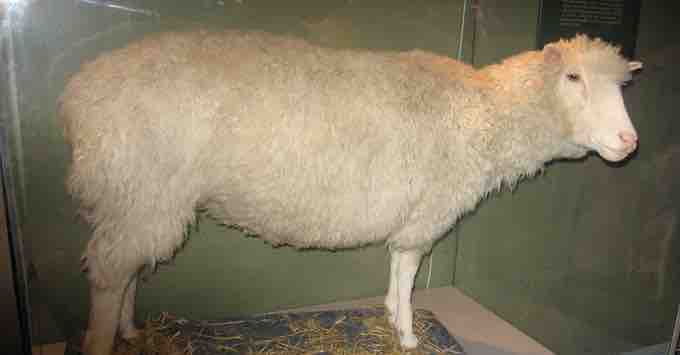The acronym "DNA" has become synonymous with solving crimes, testing for paternity, identifying human remains, and genetic testing. DNA can be retrieved from hair, blood, or saliva. Each person's DNA sequences are unique, and it is possible to detect differences between individuals within a species on the basis of these unique features. DNA testing can also be used to identify pathogens, identify biological remains in archaeological digs, trace disease outbreaks, and study human migration patterns. In the medical field, DNA is used in diagnostics, new vaccine development, and cancer therapy. It is now also possible to determine predispositions to some diseases by looking at genes.
Cloning
Reproductive cloning is a method used to make a clone or an identical copy of an entire multicellular organism. In cloning both the original organism and the clone have identical DNA. Identical twins are, in one sense, clones of each other; they have identical DNA, having developed from the same fertilized egg. Cloning became an issue in scientific ethics when a sheep became the first mammal cloned from an adult cell in 1996. Since then several animals such as horses, bulls, and goats have been successfully cloned, although these individuals often exhibit facial, limb, and cardiac abnormalities.

Modern understanding of DNA structure and function has led to cloning
Dolly the sheep was the first large mammal to be cloned.
There have been attempts at producing cloned human embryos as sources of embryonic stem cells, sometimes referred to as 'cloning for therapeutic purposes'. Therapeutic cloning produces stem cells to attempt to remedy detrimental diseases or defects (unlike reproductive cloning, which aims to reproduce an organism). Still, therapeutic cloning efforts have met with resistance because of bioethical considerations.
CRISPR
CRISPR (Clustered, Regularly-Interspaced Short Palindromic Repeats) allows scientists to edit genomes, far better than older techniques for gene splicing and editing. The CRISPR technique has enormous potential application, including altering the germline of humans, animals and other organisms, and modifying the genes of food crops. Ethical concerns have surfaced about this biotechnology and the prospect of editing the human germline and making so-called 'designer babies'.
Genetically Modified Organisms
A genetically modified organism (GMO) is any organism whose genetic material has been altered using genetic engineering techniques. GMOs are a source of medicines and genetically modified foods and are also widely used in scientific research, along with the production of other goods. Genetic modification involves the mutation, insertion, or deletion of genes. Inserted genes usually come from a different species in a form of horizontal gene-transfer.
Glo Fish
The GloFish is a patented and trademarked brand of genetically modified (GM) fluorescent fish. A gene that encodes the green fluorescent protein, originally extracted from a jellyfish, that naturally produced bright green fluorescence was inserted into a zebrafish embryo.
Bacteria, plants, and animals have been genetically modified since the early 1970s for academic, medical, agricultural, and industrial purposes. In the US, GMOs such as Roundup-Ready soybeans and borer-resistant corn are part of many common processed foods. As in many of these biotechnology areas there is considerable controversy in the use of GMOs.